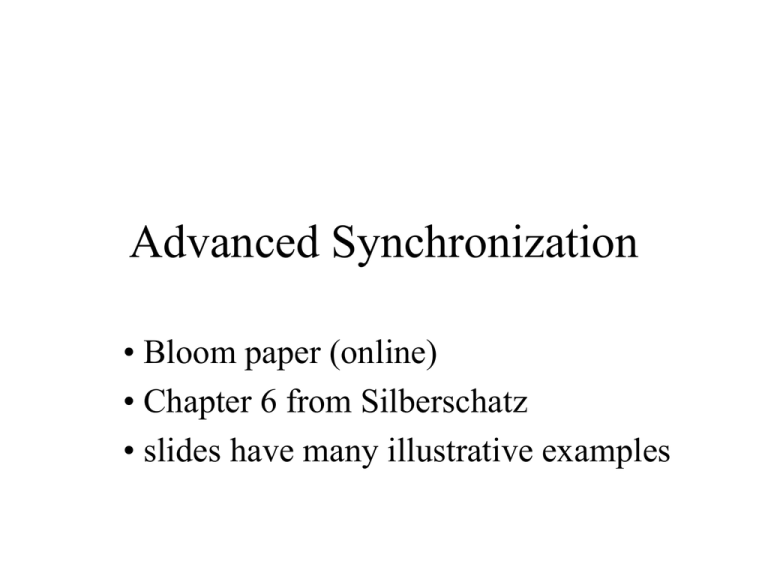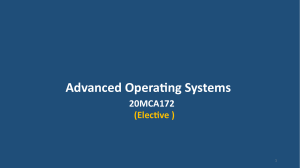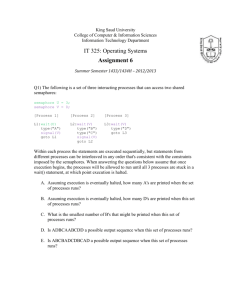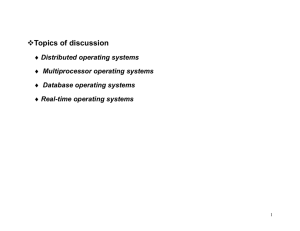Synchronization
advertisement

Advanced Synchronization
• Bloom paper (online)
• Chapter 6 from Silberschatz
• slides have many illustrative examples
Support for Critical Section
• Hardware support: Some hardware instructions
are provided to support the programmer
– (e.g., ‘test&set’, and ‘swap’ instructions)
• Operating System Support: Operating system
supports for the declaration of data structures and
also operations on those data structures
– (e.g., semaphores)
• High Level Language Support: Language
provides support for data structures and operations
on them to help with synchronization.
– (e.g., critical regions, monitors, serializers, etc)
Synchronization Building Blocks
• Most synchronization on symmetric multiprocessors is
based on an atomic test and set instruction in hardware
– we need to do a load and store atomically
• Example:
try_again:
ldstub address -> register
compare register, 0
branch_equal got_it
call go_to_sleep
jump try_again
got_it:
return
– ldstub: load and store unsigned byte (SPARC)
• Other kinds of atomic primitives at the hardware level may
be even more powerful
– e.g., compare_and_swap(mm, reg1, reg2)
(if mm==reg1, mm=reg2)
Limits on low-level mechanism
• no abstraction and modularity
– i.e., a process that uses a semaphore has to
know which other processes use the semaphore,
and how these processes use the semaphore
– a process cannot be written in isolation
• error-prone
– change order or omit lock/unlock, signal/wait
• difficult to verify correctness
Higher-level constructs
Language Support
• monitors, serlializers, path experssions,
conditional critical regions, RWlocks…
• mainly programming languages targeted for
concurrent programming and object
oriented languages: Concurrent Pascal (Path
Pascal), Concurrent C, Java, Modula, Ada,
Mesa, Eiffel, …
• use constructs provided by language and trust
compiler to translate them
– data structures need to be created (for queues, counts,
locks, etc.)
– lock/unlock and signal/wait primitives will be invoked
on the right mutex/semaphore/condition variables
• at the lowest level these will most likely translate
to test&set atomic instructions or OS-supported
semaphores
Requirements of Synch Mech
• modularity
– separation of resource and its access operations, and
synchronizer and its mechanisms
• expressive power
– specifying the needed constraints (exclusion and
priority constrains in terms of relevant information…)
• ease of use
– composing a set of constraints (for complex synch.
schemes)
• modifiability
– changing the constraints if needed
• correctness
– safety net against inadvertent user errors
Basic Mechanisms
• mutex lock
• condition variables
• semaphores
• Proposed in 1969 by Dijkstra for process synchronization
“Cooperating Sequential Processes”
– P(S):
while S <= 0 do nothing; // busy wait
S = S - 1;
– V(S):
S = S + 1;
– Init_Sem(S, Count): S = Count;
– enables mutual exclusion, process synch;
Semaphore concept
• Integer variable, with initial non-negative value
• Two atomic operations
– wait
– signal (not the UNIX signal() call…)
– p & v (proberen & verhogen), up and down, etc
• wait
– wait for semaphore to become positive, then decrement
by 1
• signal
– increment semaphore by 1
Semaphore without busy-wait
struct sem {
value: int;
L: list of processes
} S;
Init_Sem(S, Count)
{
S.value = Count;
}
– OS support
• block
• wakeup
• P and V atomic
P(S)
{S.value = S.value -1;
if (S.value < 0) {
add T to S.L;
block;
}
V(S)
{S.value = S.value + 1;
if (S.value <=0) {
select a T from S.L;
wakeup(T);
}
Mutual exclusion using
semaphores
• Use wait and signal like lock and unlock
– bracket critical sections in the same manner
• Semaphore value should never be greater than 1
– This is a binary semaphore
• Depends on correct order of calls by programmer
• All mutex problems apply (deadlock…)
• What should the initial value be?
Resource counting
• A counting semaphore can take on arbitrary
positive values
– max value usually system dependent but tunable
• General idea
–
–
–
–
initialize semaphore value to # of resources
wait = acquire resource
signal = relinquish resource
when all resources are taken, wait will… well, wait.
• Default semaphore type is usually counting
– …. easy to make it a mutex
Monitors
• Monitors are a synchronization mechanism where the shared
data are encapsulated with the locks required to access them
– Variables/data local to a monitor cannot be directly accessed from
outside.
• the data can only be accessed through the locked code
mon_name (ep1, ep2, …, epn)
{
entry_point ep1
entry_point ep2
{
{
}
}
}
– all ep’s are mutually exclusive
– multiple threads inside the monitor?
• yes, but only one active
• others?
– waiting on an event
…...
…...
……
Monitors ..
Silberschatz textbook 6.7. example of Monitor
implementation with semaphores (structure for each condition
x, actions for x.wait and x.signal…)
Process a
Process b
Procedure i
Procedure j
ConditionVariable.wait
Queue for each
conditional
variable
Only one
process at a
given time
ConditionVariable.signal
Data
Designing a Monitor
•
When a process is active inside a monitor, other processes get
queued up.
•
Queuing up: done by operation wait. Dequeuing by signal.
•
Queuing/dequeuing up: more than 1 reason possible. E.g.,
waiting for a reader to depart, waiting for a writer to finish, ..
•
Condition variable may be associated with wait and signal.
–
E.g., OKtoread.wait, OKtoread.signal, …
•
Queues: generally FIFO, priorities may be implemented with a
parameter.
•
signaling threads immediately relinquish control of the
monitor (in original definition)
–
this means they cannot signal multiple condition variables at the same
time!
Monitor-style programming
• With mutexes and condition variables you can
implement any critical section
CS_enter(); [controlled code] CS_exit();
void CS_enter() {
Lock(m) {
while (![condition])
Wait(c, m)
[change shared data
to reflect in_CS]
[broadcast/signal as needed]
}
}
void CS_exit() {
Lock(m) {
[change shared data
to reflect out_of_CS]
[broadcast/signal as needed]
}
}
• Readers/Writer example structure:
monitor
{ Condition OKtoread, OKtowrite;
int readercount;
// data decls
void StartRead() { ... }
void StartWrite() { ... }
void FinishRead() { ... }
void FinishWrite() { ... } }
Reader’s Priority: Monitors
readers-writers: monitor;
begin // the monitor
readercount: integer;
busy: boolean;
OKtoread, OKtowrite: condition;
procedure StartRead;
begin
if busy then OKtoread.wait;
readercount := readercount + 1;
OKtoread.signal; // all readers can start
end StartRead;
procedure EndRead;
begin
readercount := readercount - 1;
if readercount = 0 then OKtowrite.signal;
end EndRead;
Reader’s Priority: Monitors ...
procedure StartWrite;
begin
if busy OR readcount != 0 then
OKtowrite.wait;
busy := true;
end StartWrite;
procedure EndWrite;
begin
busy := false;
if OKtoread.queue then
OKtoread.signal;
else OKtowrite.signal;
end EndWrite;
begin // initialization
readercount := 0; busy := false;
end;
end readers-writers.
Readers-Writers: Monitors
Reader:
StartRead();
ReadFile();
EndRead();
Writer:
StartWrite();
WriteFile();
EndWrite();
Monitors: Drawbacks
•
•
•
Only one active process inside a monitor: no concurrency.
Previous example: File NOT inside monitor to allow
concurrency. -> Responsibility of readers and writers to
ensure proper synchronization.
Nested monitor calls can lead to deadlocks:
–
–
–
•
•
Consider monitors X and Y with procedures A and B. Let X.A call
Y.B and vice-versa
A process P calls X.A, process Q calls Y.B.
P is blocked on Y.B and Q is blocked on X.A
Responsibility of valid programs shifts to programmers,
difficult to validate correctness.
“low-level” – explicit signalling needed, no connection
between abstract condition and signalling, signaller has to
choose which queue to signal – explicit priorities…
• use
– embed resource in mon (e.g. access to b-buffer)
• problem?
all ops mutually exclusive
– resource outside mon
• permission to access inside mon
• does not prevent resource being called directly
• monitors vs. semaphores?
– exercise: implement one using the other
• scorecard for monitor
– modularity and correctness (low)
– ease of use, modifiability, expr. power (OK)
Monitors in Java
• keyword “synchronized” can be used to identify
monitor regions (statements, methods, etc).
• compiler generates monitorenter and monitorexit
bytecodes when monitor region is statements
within a method
• JVM acquires and releases lock to corresponding
object (or class)
• locks are recursive
• single condition variable associated with object
that has monitor
• notify() semantic is Signal-and-Continue, i.e. have
to verify that indeed the condition is true!
Example - pseudocode
import Utilities.*;
import Synchronization.*;
class BoundedBuffer extends MyObject {
private int size = 0;
private double[] buf = null;
private int front = 0, rear = 0, count = 0;
public BoundedBuffer(int size) {
this.size = size;
buf = new double[size];
}
public synchronized void deposit(double data) {
if (count == size) wait();
buf[rear] = data;
rear = (rear+1) % size;
count++;
if (count == 1) notify();
}
public synchronized double fetch() {
double result;
if (count == 0) wait();
result = buf[front];
front = (front+1) % size;
count--;
if (count == size-1) notify();
return result;
}
}
Producer/Concumer
Bounded Buffer with Monitor
Monitor
PBBuffer b : BBuffer; // This is an unprotected
bounded buffer
count : Integer;
empty, full : condition;
procedure Init;
begin
init(empty); init(full); init(b); count := 0;
end;
procedure Enqueue(I : Item)
begin
if count == BufferSize(b) then wait(full);
//BufferSize returns the maximum size of b
count++;
Enqueue(b, I);
signal(empty);
end;
procedure Dequeue(I : out Item)
begin
if count == 0 then wait(empty);
count--;
Dequeue(b, I);
signal(full);
end;
Dining Philosophers Problem
[this solution is not fair]:
Monitor DiningPhilosophers
HMNY : constant integer = {the number of
philosophers};
HMNY1 : constant integer = HMNY - 1;
state : array[0 .. HMNY1] of (thinking, hungry,
eating) = (thinking, .., thinking);
self : array[0 .. HMNY] of condition;
{We assume self's conditions
are initialized}
function Left(K : 0 .. HMNY1) return 0 .. HMNY1 is
{This is an operation only
used within the monitor}
begin
return (K+1) mod HMNY;
end;
function Right(K : 0 .. HMNY1) return 0 .. HMNY1 is
{This is an operation only
used within the monitor}
begin
return (K-1) mod HMNY;
end;
procedure Test(K : 0 .. HMNY1)
{This is an operation only
used within the monitor}
begin
if state[Left(K)] /= eating and
state[K] == hungry and
state[Right(K)] /= eating
then
{ state[K] = eating; signal(self[K]); }
end;
procedure Pickup(I : 0 .. HMNY1)
begin
state[I] = hungry;
Test(I);
if state[I] /= eating
then wait(self[I]);
end;
procedure PutDown(I : 0 .. HMNY1)
begin
state[I] = thinking;
Test(Left(I));
Test(Right(I));
end;
Each philosopher Pi will execute a simple loop:
loop
think;
DiningPhilosophers.PickUp(i);
eat;
DiningPhilosophers.PutDown(i);
forever;
Semaphore with Monitor
MONITOR monSemaphore;
VAR
semvalue : INTEGER;
notbusy :
CONDITION;
PROCEDURE monP;
BEGIN
IF (semvalue = 0)
THEN
WAITC(notbusy)
ELSE
semvalue :=
semvalue - 1;
END;
PROCEDURE monV;
BEGIN
IF (EMPTY(notbusy))
THEN
semvalue :=
semvalue + 1
ELSE
SIGNALC(notbusy);
END;
BEGIN { initialization
code }
semvalue := 1;
END; // of monSemaphore
monitor
Serializers
• Serializers was a mechanism proposed in 1979
to overcome some of the monitors’ shortcomings
– more automatic, high-level mechanism
– basic structure is similar to monitors
• Data types
– queue – takes place of CVs, but there is no signal op, the wait
is replaced by enqueue
– crowd
• operations
– enqueue (queue_name) until <predicate>
– join (crowd_name) then { <stmts> }
• implicitly relinquishes control of serializer
– empty(crowd_name or queue_name)
– resource access
Serializers enqueue (<priority>,<qname>)
until (<condition>)
join-crowd (<crowd>) then
(<body>) end
Only 1 active process
Multiple active processes
serializer vs. monitor
• difference from monitor
– resource ops can be inside the serializer (***)
– no explicit signaling
– explicit enqueuing on queues
– automatic thread resumption (dequeue)
– Serializers are similar to monitors with two main
differences:
• they allow concurrency
• they have an automatic signalling mechanism
– A serializer allows access to a resource without mutual
exclusion, although the resource is inside the serializer
– built in priorities:
• threads on queue when condition true
• threads leaving crowd
• threads entering crowd
• Operation semantics:
– enqueue is like Wait, only the Signal happens
automatically when condition is true, the thread is at the
head of the queue, and some other thread leaves the
serializer
– join_crowd leaves the serializer, executes a block
without mutual exclusion, but returns to the serializer
when the block finishes
• Use of Serializers
– Usual sequence of events for a thread:
enter serializer
enqueue waiting for event (if needed)
dequeue (automatic)
join crowd to start using resource
leave crowd (automatic)
exit serializer
Reader’s Priority: Serializers
Readerwriter: serializer
var
readq: queue; writeq: queue;
rcrowd: crowd; wcrowd: crowd;
db: database;
procedure read(k:key; var data: datatype);
begin
enqueue (readq) until empty(wcrowd);
joincrowd (rcrowd) then
data:= read-db(db[key]);
end
return (data);
end read;
procedure write(k:key, data:datatype);
begin
enqueue(writeq) until
(empty(rcrowd) AND empty(wcrowd) AND
empty(readq));
joincrowd (wcrowd) then write-db(db[key], data);
end
end write;
Readers-Writers in Serializers ...
• Weak reader’s priority
– enqueue(writeq) until
(empty(wcrowd) AND empty(rcrowd));
– A writer does not wait until readq becomes empty
• Writer’s priority
– enqueue(writeq) until
(empty(wcrowd) AND empty(rcrowd));
– enqueue(readq) until
(empty(wcrowd) AND empty(writeq));
Serializers: Drawbacks
•
•
•
•
•
•
More complex, may be less efficient
More work to be done by serializers
“crowd” : complex data structure; stores identity of
processes,…
“queue”: count, semaphore, predicate…
Assumes automatic signaling feature: test conditions of
every process at the head of every queue every time a
process comes out of a serializer.
Though it (automatic signalling) helps in avoiding
deadlocks and race conditions.
Serializers: pros and cons
• Pros:
– clean and powerful model addresses monitors’
drawbacks
– allows concurrency of encapsulated resources
– automatic signaling simplifies programming
• Cons
– more complex so less efficient
– automatic signaling requires testing conditions
every time possession of serializer is relinquished
• scorecard for serializer
– modularity and correctness (high); ease of use (high)
– modifiability (OK); expr. power (OK)
– efficiency (low)
Path Expressions
• Path expressions are declarative specifications of allowed
behaviors of a concurrent program
– synchronization is a mere side-effect of ordering the executions of
operations on a resource
• To implement path expressions, a run-time system (path
controller for each instance of shared resource) is needed to
check the validity of orderings
– it keeps track of operation start and end
– it blocks threads if their execution of an operation will violate the path
expression
– important: automatically unblocks when execution can go on
• Path expressions do not cause the operations to be executed
and do not determine who executes the operations
Path Expressions
• sync for data abstraction part of definition
• path expression specifies allowed orderings
• syntax: path S end;
– S is an expression whose variables are the
operations on the resource, and the
operators are
•
•
•
•
; (sequencing)
+ (selection)
{ } (concurrency)
path-end (repetition)
– unsynch. access to ops not in path
Operator semantic
• ; (sequencing) defines a obliged sequencing
order between operations.
– no concurrency between operations
• + (selection) means only one of the
operations can be executed at a time
– the order of executions does not matter
• { } (concurrency) means any number of
instances of the embraced operations can be
executing at a time
• example
– path {read} + write end
• multiple readers or single writer
– priority?
• none
– path expression does not cause op invocation
– several path expressions in a module; the
ordering has to be consistent with all paths
– after a legal execution, another legal execution
may follow
– path open; read; close; end
• sequentially one after the other
• no mention of WHO executes the op in path expr.
• path A end
– a sequence of As (the path between path and end can be
repeated)
• path {A} end
– concurrent As
• path {A;B}+C end
– the nth B can start only after n As have finished
– any C will be preceded by zero or n concurrent A;B,
where all As and Bs have finished
• path {A + B};C end
– the nth B can start independent of how many As have
started or finished before it
– all the As and Bs that have started have to complete
before a C is allowed to go
• Readers/Writer (basic):
path { read } + write end
• Writes and reads interleaved (at least 1 read):
path write ; { read } end
•
•
•
•
•
•
•
path a + b; c end
path a + (b; c) end;
path {a} + {b} end;
path {a + b} end;
path {a; b} end;
path {(a;b) + c} end
path {a; b+c} end
Usage
• Each path expression is associated with a
single resource
• Path expressions are used encapsulated with
the operations for a resource:
class file {
path write ; { read } end
void write(...) { ... };
int read() { ... } }
Path Expressions in Path Pascal
• Path Pascal – extension of Pascal that
includes directives for specifying Path
Expressions, and uses Object
Encapsulations and Processes
• to specify priorities may need to introduce
“artificial” operations
– in Bloom’s paper, not just “read/write” but
“start read/write”, “read/write”…
• Readers priority (weak):
path {read} + write end
– either several reads or a write
• Writer’s priority:
path write end
path start_read + {start_write; write} end
path {start_read; read} + write end
– 3rd expression: no reader can execute start_read when a
writer is writing
– 2nd expression: a writer can start a write when a writer is
writing or when a reader is reading (start_read cannot be
concurrent with start_write, however read can)
– 1st expression: only one reader at a time
/* A CS for up to 2 concurrent threads */
path request_enter + exit + do_enter end
// means these are mutually exclusive
path enter end
// means that instances are exclusive
path {wait ; release ; do_enter} + do_enter
end
count = 0;
private:
wait() { }
release() { }
request_enter() {if (count >= 2) wait();}
do_enter() { count++ }
public:
enter() { request_enter(); do_enter(); }
exit() { count--; release(); }
Producer/Consumer Problem
CONST nbuf = 5;
TYPE bufrange = 1..5;
ring = OBJECT
PATH nbuf:(1:(put); 1:(get)) END;
VAR buffer : ARRAY [bufrange] OF CHAR;
inp, outp : bufrange;
ENTRY PROCEDURE put(x : CHAR);
BEGIN inp := (inp MOD nbuf) + 1;
buffer[inp] := x
END
ENTRY FUNCTION get: CHAR;
BEGIN outp := (outp MOD nbuf) + 1;
get := buffer[outp]
END
INIT;
BEGIN inp := nbuf;
outp := nbuf
END
END (* end of OBJECT *)
VAR buf : ring;
c : CHAR;
BEGIN buf.put('a');
c := buf.get
END;
Dining philosopher Problem
CONST nphilopophers = 5;
maxindex = 4; (* nphilopophers - 1 *)
TYPE diner = 0..maxindex;
VAR i: integer;
table : OBJECT
PATH maxindex:(starteating; stopeating) END;
VAR fork: ARRAY [diner] OF OBJECT
PATH 1:(pickup; putdown) END;
ENTRY PROCEDURE pickup; BEGIN END;
ENTRY PROCEDURE putdown; BEGIN END;
END;
ENTRY PROCEDURE starteating(no: diner);
BEGIN fork[no].pickup;
fork[(no+1) MOD nphilsophers].pickup;
END;
ENTRY PROCEDURE stopeating(no: diner);
BEGIN fork[no].putdown;
fork[(no+1) MOD nphilsophers].putdown;
END;
END; (* table *)
PROCESS philsopher (mynum: diner);
BEGIN REPEAT
delay(rand(seed));
table.starteating(mynum);
delay(rand(seed));
table.stopeating(mynum);
UNTIL FALSE; END;
(* main *)
BEGIN
FOR i:= TO maxindex DO philsopher(i)
END.
Comments on Path Expressions
• Path expressions can be complex
– they may require the addition of “artificial” operations
– it is not clear that a specification is correct when it
spans several different resources (each with its own
path expressions and operations depending on each
other)
• But the specifications are declarative and
centralized (i.e., there is no need to look through
the code to find the synchronization primitives)
• For synchronization on a single resource, path
expressions may be fine
– scorecard
• expressive power, modularity (high)
• priority constraints (low)
• correctness (depends)
ReaderWriter Locks
• Abstraction in Java, MS .NET, other places
• Manages read and write locks so you don’t
have to
• Also handles scheduling of blocked threads
– Java implements WriterPreference,
ReaderPreference classes which implement
ReadWriteLock interface
RWLocks
• Bracket critical sections as with normal mutexes
• You say whether you’re locking for read or write –
it does the “right” thing
• Downgrade/upgrade
– reduce overhead when switching from read to write
– priority over those with no locks when upgrading
• Very useful for caches
– or anywhere readers >> writers – Java Swing GUI
threads, etc
• For small critical sections, it may be overkill
– need larger CS to get benefit of concurrent readers
Conditional Critical Regions
• Silverschatz textbook 6.6 (and implementation with
semaphores)
var v: shared t
region v when {Condition} do Statements
• the developer does not have to program the
semaphore or alternate synchronization explicitly
• the compiler ``automatically'‘ plugs in the
synchronization code using predefined libraries
• once done carefully, reduces likelihood of mistakes in
designing the delicate synchronization code
Synchronization support for concurrency
problems using programming languages
• monitors (shared memory support)
– Concurrent Pascal (Hansen), Modula (Wirth), Mesa
(Xerox), uC++ (Buhr), Emerald (Raj)
• path expressions (shared memory support)
– Path Pascal (Habermann and Campbell)
• message passing (non-shared memory support)
– CSP: Communicating Sequential Processes (Hoare)
• serializers
– Eifel
• RPC/rendezvous (non-shared memory support)
– Ada for rendezvous
Lock free synchronization
• basic idea
– if mostly just read operations, and no updates,
then don’t lock
– instead:
• catch update/write operations
• allow to perform a change in a separate copy
• wait until all current reads complete (or something
similar) then apply the update







